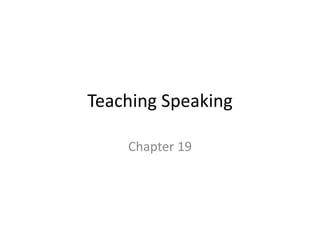
Teaching speaking
- 2. Contents • Oral communication skills in pedagogical Research • Types of spoken language • What makes speaking difficult? • Micro- and macro-skills of oral communication • Types of classroom speaking performance • Principles for teaching speaking skills • Teaching conversation • Teaching pronunciation • Focus on form and error treatment • The role of feedback • When and how to treat errors • Assessing speaking in the classroom • Item types and tasks for assessing speaking • Evaluating and scoring speaking tasks
- 3. Oral communication skills in pedagogical research Some current issues in teaching oral communication: 1) Conversational discourse: The benchmark of successful language acquisition is almost always the demonstration of an ability to accomplish pragmatic goals through interactive discourse with other speakers of the language. Some parameters of CD transactional vs. interactional conversation; rules of topic nomination, maintaining a conversation, turn taking, interruption, and termination; sociolinguistic appropriateness; style of speech; nonverbal communication
- 4. Some current issues in teaching oral communication: 2) Teaching pronunciation: While majority of adult learners will never acquire an accent-free command of a FL, should a language program focus on tiny phonological details of language? How much emphasis should be put on them?
- 5. Some current issues in teaching oral communication: 3) Accuracy and fluency 4)Affective factors & language ego 5)The interaction effect & interlocutor effect 6) Question about intelligibility (Are NNSs intelligible ? ) 7) The growth of spoken corpora (data from spoken Englishes) 8) Genres of spoken language
- 6. Types of spoken language 1) Interpersonal or interactional dialogue 2) Transactional dialogue
- 7. What makes speaking difficult? 1. Clustering (Fluent speech is phrasal, not word by word.) 2. Redundancy (Through redundancy ,the meaning can be clearer.) 3. Reduced forms (contractions, elisions, reduced vowels) 4. Performance variables (hesitations, pauses, backtracking, corrections) 5. Colloquial language 6. Rate of delivery (RD is salient factor of fluency.) 7. Stress, Rhythm and intonation 8. Interaction
- 8. Micro- and macro-skills of speaking • See page 328
- 9. Types of classroom speaking performance 1. Imitative (e.g. drills to loosen the tongue) 2. Intensive (self-initiated or part of group work to practice phonological and grammatical aspects) 3. Responsive (e.g. short replies to the teacher) 4. Transactional dialogues (conveying information) 5. Interpersonal dialogue (maintaining social relationship) e.g. p.330 6. Extensive (monologue) e.g. short speeches
- 10. Principles for teaching speaking skills 1. Focus on both fluency and accuracy 2. Provide intrinsically motivating techniques 3. Encourage to use authentic language in meaningful contexts 4. Provide appropriate feedback and correction 5. Capitalize on the natural link between speaking and listening 6. Give students opportunities to initiate oral communication 7. Encourage the development of speaking strategies (e.g p. 332)
- 11. Teaching Conversation 1. Direct approach: involves planning a conversation program around the specific micro- skills, strategies, and processes that are involved in fluent conversation. 2. Indirect approach: Learners set more or less loose to engage in interaction or meaningful tasks like TBLT. Nunan (2004) + Ellis (2003) + Willis (1996) emphasize on inclusion of focus on form (FFI)- analysis and practice of language forms as an integral part of every task (e.g. pp.334-339).
- 12. Teaching Pronunciation • ALM of 40’s and 50’s • CLT and balance between accuracy and fluency pronunciation a key to gain full command of communicative competence Bottom-up approach starts from teaching phonemes and allophones … Top-down approach give primary attention to stress, rhythm and intonation
- 13. A question? • Should the ultimate goal in pronunciation be accent-free speech that is indistinguishable from that of a native speaker?
- 14. A question? • Should the ultimate goal in pronunciation be accent-free speech that is indistinguishable from that of a native speaker? • Such goal is not only unattainable for virtually every adult learner, but in a multilingual, multicultural world, accents are quiet acceptable. Native accents have become almost irrelevant to cross-cultural communication. • Focus should be on clear, and comprehensible pronunciation.
- 15. Factors affecting pronunciation • Native Language: being familiar with sound systems of both languages helps diagnosing the difficulties. • Age: Children under the age of puberty have an excellent chance of ‘sounding like native speakers’; ‘the younger, the better’ is a myth.
- 16. Factors affecting pronunciation • Exposure: The quality and intensity (not mere length of time) are important. • Innate phonetic ability (= having an ear for language): whether or not u have a ‘knack’ for pronunciation, with some effort and concentration, u can improve your pronunciation.
- 17. Factors affecting pronunciation • Identity and language ego: the learner’s emerging identity + positive attitude towards the language and the speakers of the language • Motivation and concern for good pronunciation: intrinsic and extrinsic motivation
- 18. Focus on form and error treatment The role of feedback (Vigil ans Oller, 1979, p.345) 1)Affective feedback 2)Cognitive feedback
- 19. Focus on form and error treatment When and how to treat errors When (Hendrickson, 1980): Global vs. Local errors: Examples For hotel description: There is a French widow in every bedroom. The different city is another one in the another two. The grammar is the basement of every language.
- 20. Focus on form and error treatment When and how to treat errors How? Error correction vs. error treatment p.347 Williams (2005): the best way to help a learner to repair malformed utterance is, first to assist the learner in noticing an incorrect form and second to initiate repair.
- 21. A model for treatment of classroom speech errors • Page 349 the flawchart
- 22. Assessing speaking in the classroom • P.351 item types and tasks
- 23. Evaluating and scoring speaking tasks • 6 possible criteria: 1. Pronunciation 2. Fluency 3. Vocabulary 4. Grammar 5. Discourse features (cohesion, sociolinguistic appropriateness, etc.) 6. Task (accomplishing the objectives of the task)